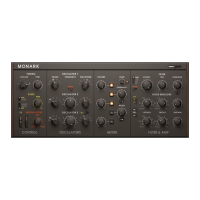While the switch to enable oscillator pitch modulation is placed in the FREQUENCY section,
the form of modulation available in MONARK is technically not frequency but pitch modula-
tion (which is also true for the modulation of the filter cutoff). Pitch modulation differs from
frequency modulation in that the frequency of the target is modulated in a logarithmic and not
linear fashion.
Pitch modulation does something odd to the sound: the target oscillator gets distorted in a way
that the perceived fundamental pitch of the sound changes! In other words, the sound is de-
tuning. This is not a mistake but immanent to the method!
The amount of detuning is dependent on the amount of modulation, the modulation wheel set-
ting. To correct the tuning of the oscillators, you can use the global fine-tuning knob, though
keep in mind that this correction is only true for one specific position of the modulation wheel.
Sound Design with the Modulation Section
The typical application of modulation is the well known vibrato—oscillator pitch modulation by
a very slow oscillator. Vibrato can be achieved by putting OSCILLATOR 3, the modulation os-
cillator, into a sort of vibrato mode. Set the RANGE selector to LO and deactivate the key-
tracking (K.T.) for OSCILLATOR 3. The vibrato speed can now be dialed in with the FREQUEN-
CY knob, the triangle waveform is normally a good choice for vibrato. With filter pitch modula-
tion this setting might also satisfy your wobble needs!
The ranges of OSCILLATOR 3's FREQUENCY knob in this vibrato setting can be set globally for
the instrument (not per Snapshot!) in View B (see ↑5.3.5, OSCILLATORS Section for details).
When the oscillation of the modulation oscillator is increased to audio range frequencies, the
effect is no longer vibrato or wobble but a dramatic change in the spectral quality of the
sound. Audio rate oscillator pitch modulation can animate the sound in a subtle way, especial-
ly if the oscillators are tuned to nearly the same pitch, or it may completely enter inharmonic
territory: Take for example snapshot "Metallurg" (Snapshot 25) in the "Perc/Seq" Bank and play
with the FREQUENCY knob of OSCILLATOR 3. As you can hear, oscillator pitch modulation is
capable of creating a variety of metallic sounds.
With filter pitch modulation (especially with high amount of resonance) we can have a setup
that is close to oscillator pitch modulation, with the difference that it still can process incom-
ing audio signals from the mixer. Some interesting voice like sounds can be achieved that way!
Overview of MONARK Ensemble
View A—Overview of MONARK User Interface
MONARK - Manual - 36

